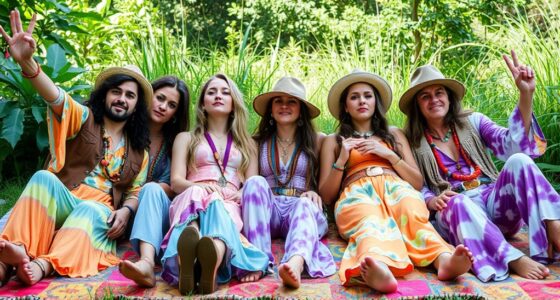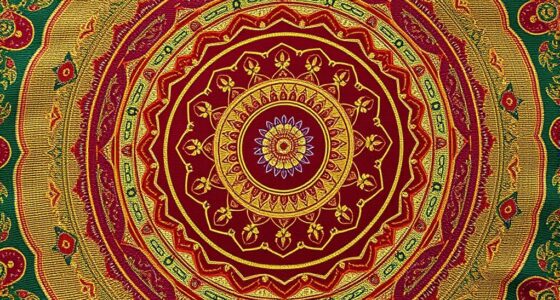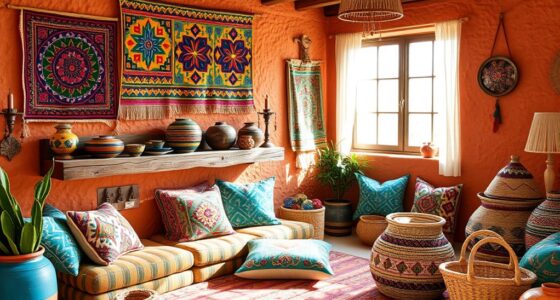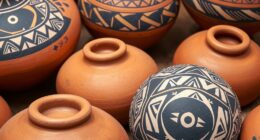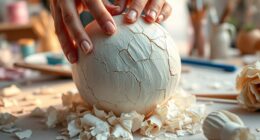Scandinavian folk art features vibrant patterns rooted in centuries of cultural traditions, regional influences, and spiritual symbols. You’ll notice motifs like floral designs, geometric shapes, and animal symbols that tell stories of protection, growth, and community. Bright colors like red, blue, green, and white highlight the craftsmanship. If you explore further, you’ll discover how these motifs evolve into modern styles and how they’re preserved in art, textiles, and home decor today.
Key Takeaways
- Scandinavian folk art features vibrant patterns symbolizing fertility, protection, and nature’s power, with regional variations in floral and geometric motifs.
- Traditional colors like reds, blues, greens, whites, and blacks carry symbolic meanings related to vitality, fertility, and spiritual beliefs.
- Common motifs include animal symbols, floral designs, spirals, and crosses that encode cultural stories, values, and spiritual beliefs.
- Techniques such as hand-painting, natural dyes, embroidery, and textile weaving preserve traditional patterns and motifs.
- Modern interpretations blend traditional motifs with contemporary styles, ensuring cultural preservation and artistic innovation.
The History and Cultural Significance of Scandinavian Patterns

Scandinavian patterns have deep roots in the region’s history, reflecting centuries of cultural traditions and beliefs. Over time, these designs have evolved, carrying symbolic meanings that reveal insights into local life and spirituality. Historically, patterns served as visual stories, representing concepts like fertility, protection, and nature’s power. Their evolution shows a blend of indigenous practices and influences from neighboring cultures, shaping the distinctive aesthetics you see today. As you explore these patterns, you’ll notice how their symbolism connects to everyday life and communal identity. This historical evolution highlights how Scandinavian folk art preserves cultural memory and spiritual beliefs, making each pattern a meaningful reflection of the region’s rich heritage. Additionally, the continuously evolving nature of these designs demonstrates their adaptability and enduring significance across generations.
Traditional Motifs and Symbols in Folk Art

Traditional motifs and symbols are at the heart of Scandinavian folk art, serving as visual expressions of cultural beliefs and everyday life. You’ll notice that symbolic animal representations often appear, like birds and deer, representing fertility, protection, or spiritual connection. Geometric pattern symbolism also plays a key role, with patterns that convey harmony, balance, and continuity. Here are three common motifs:
Scandinavian folk art features animal symbols, floral motifs, and geometric patterns symbolizing protection, growth, and spiritual harmony.
- Animals, such as stylized horses and dragons, symbolizing strength and protection.
- Floral and plant motifs representing growth and renewal.
- Abstract geometric shapes, like spirals and crosses, embodying spiritual beliefs and community ties.
These motifs are not just decorative—they encode stories, values, and traditions that continue to define Scandinavian folk art today. Their recurring presence highlights the deep cultural significance behind each symbol. Cultural symbolism is integral to understanding the stories embedded within these patterns, reflecting the rich heritage of Scandinavian communities.
Common Color Palettes and Their Meanings
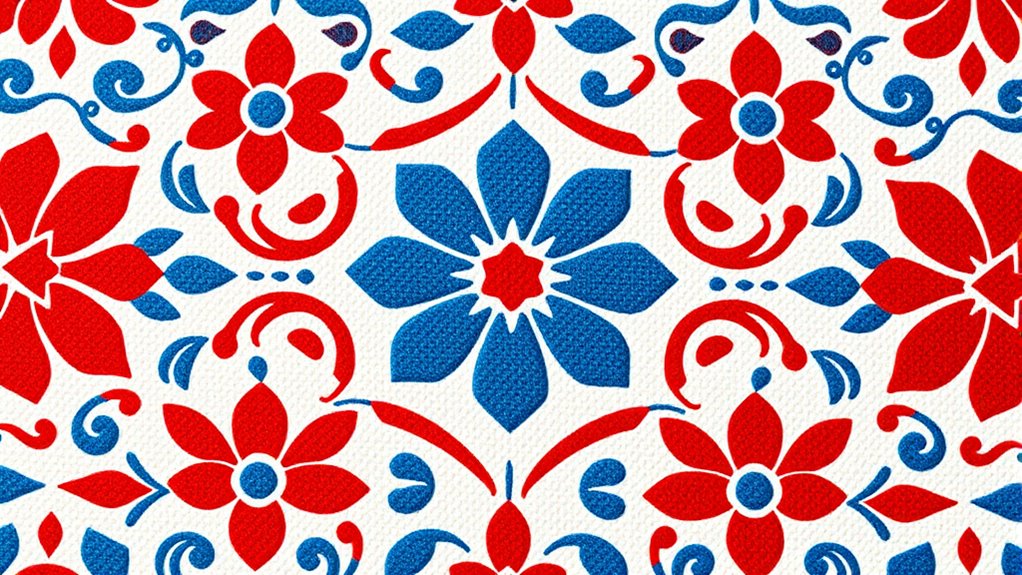
Color plays an essential role in Scandinavian folk art, conveying meaning and reinforcing cultural values through carefully chosen palettes. You’ll notice specific colors symbolize emotions and social beliefs, creating a visual language understood across generations. Bright reds and blues often represent vitality and protection, while greens symbolize fertility and nature’s abundance. Whites and blacks provide contrast and clarity, emphasizing patterns and symbols. Here’s a quick look at common color symbolism:
| Color | Cultural Associations |
|---|---|
| Red | Vitality, protection |
| Blue | Calmness, trust |
| Green | Fertility, nature |
| White | Purity, innocence |
| Black | Mystery, strength |
These palettes reflect cultural associations that deepen the meaning behind each folk art piece. Additionally, understanding the color symbolism helps in appreciating the cultural significance embedded within these patterns.
Techniques Used in Creating Folk Art Patterns
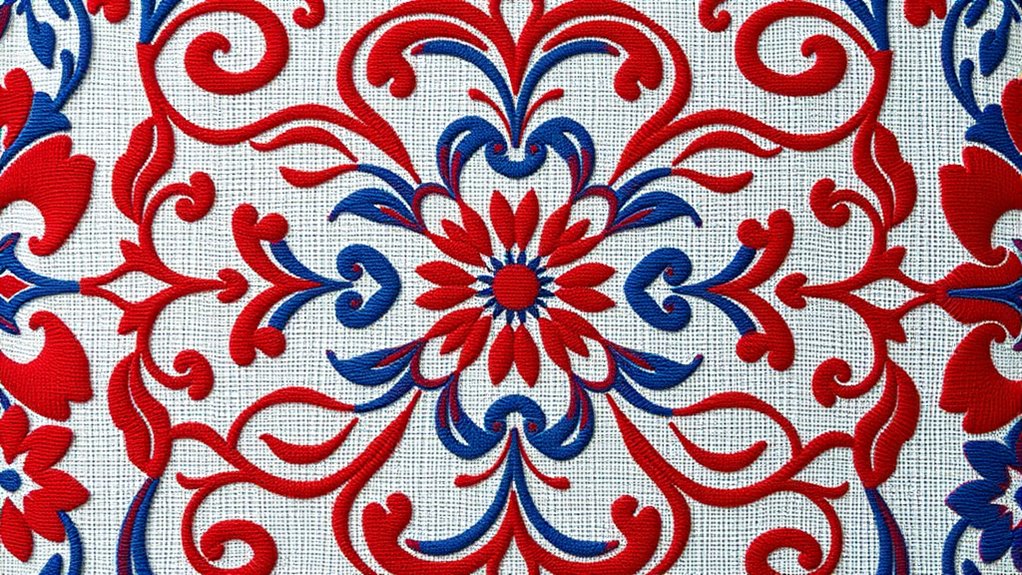
You’ll notice that Scandinavian folk art patterns are created using various techniques, each with its own unique touch. Hand-painting methods allow artists to add detailed, personal designs, while stencil and block printing produce consistent patterns across pieces. Natural dye techniques, on the other hand, infuse textiles with vibrant colors derived from local plants and minerals. Additionally, some artisans incorporate traditional cultural motifs to preserve and celebrate their heritage in every piece.
Hand-Painting Methods
Hand-painting remains an essential technique in Scandinavian folk art, showcasing skilled craftsmanship and attention to detail. Your focus is on mastering brushwork techniques and paint application methods to create vibrant patterns. To achieve the desired effects, you’ll typically follow these steps:
- Use controlled brushwork to outline and fill in motifs with precision.
- Apply paint in layers, building depth and intensity for bold colors.
- Employ specific brush strokes to add decorative details and fine accents.
- Incorporate knowledge of traditional ethics in art to ensure authenticity and respect for cultural heritage.
Stencil and Block Printing
Have you ever wondered how Scandinavian artisans create intricate folk art patterns with consistency and efficiency? They often use stencil techniques to replicate designs quickly and accurately. By cutting patterns into thin sheets of material, artisans can apply paint or dye through the openings, producing uniform motifs on textiles or wood. Similarly, block printing methods involve carving designs into wooden blocks, which are then dipped in dye and pressed onto surfaces. This technique allows for repeated patterns with precision and speed, making it ideal for large-scale decoration. Both stencil techniques and block printing methods are valued for their ability to preserve traditional motifs while streamlining the production process. These methods have helped keep Scandinavian folk art vibrant and accessible across generations, blending craftsmanship with practicality. Pattern replication techniques are essential in maintaining the consistency of traditional Scandinavian motifs.
Natural Dye Techniques
Ever wondered how Scandinavian artisans achieve vibrant and自然 hues in their folk art? They use natural dye techniques that have been refined over centuries. First, they employ indigo dyeing to produce rich blue shades by fermenting indigo leaves. Second, they use mordant techniques with natural substances like alum or iron to fix dyes and enhance color fastness. Third, artisans often prepare their textiles through pre-treatment, ensuring the fabric absorbs dyes evenly. These methods allow for deep, lasting colors and intricate patterns characteristic of Scandinavian folk art. Additionally, understanding the proper application of heat and mordants is crucial for achieving the desired effects for color enhancement. By mastering these techniques, artisans create stunning, durable textiles that reflect their cultural heritage and connection to nature. Natural dyeing remains a crucial craft, preserving tradition while producing vibrant, eco-friendly colors.
Regional Variations in Design and Style
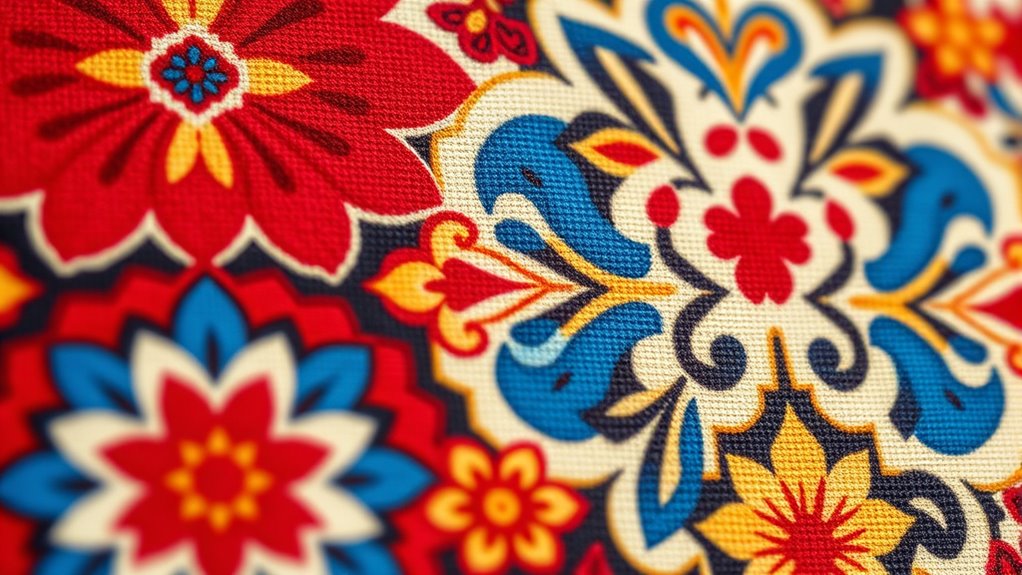
You’ll notice that Scandinavian folk art varies profoundly across regions, especially in the use of Nordic floral motifs. In some areas, these designs are intricate and colorful, while in others, they’re more restrained and geometric. The Sami culture also influences certain styles, adding unique patterns and symbols that stand out from traditional Scandinavian designs. Additionally, understanding water-themed motifs can reveal a lot about the cultural significance and regional influences in Scandinavian folk art.
Nordic Floral Motifs
What makes Nordic floral motifs uniquely enchanting is how they reflect regional landscapes and cultural influences. You’ll notice that each area develops its own style, emphasizing local flora and traditions. For example, in some regions, flower crowns are common, symbolizing celebration and nature’s bounty. Berry patterns also add a distinct touch, representing the importance of wild berries in Scandinavian life. To better understand these variations:
- Flower crowns often feature delicate, swirling petals, showcasing regional flora.
- Berry patterns are bold and repetitive, highlighting the significance of nature’s resources.
- Color palettes differ; some areas favor vibrant reds and greens, while others opt for softer pastel shades.
- The choice of motifs is often influenced by tire pressure and terrain, subtly reflecting the landscape’s diversity.
These elements combine to create motifs that are both region-specific and rooted in cultural identity, making Nordic floral designs truly mesmerizing.
Sami Cultural Influence
Building on the regional diversity seen in Nordic floral motifs, Sami cultural influence introduces a distinctive style characterized by bold patterns and symbolic designs. You’ll notice Sami jewelry often features intricate silver work combined with vibrant colors, reflecting their rich traditions. Reindeer symbolism plays a central role, symbolizing sustenance, community, and spiritual connection. These motifs frequently appear in clothing, accessories, and decorative items, showcasing geometric shapes and stylized reindeer images. The designs emphasize simplicity yet carry deep meaning, highlighting the Sami people’s close relationship with nature and reindeer herding. Incorporating emotional connection into their folk art, the Sami create a visual language that’s both striking and significant, celebrating their identity and cultural heritage through unique patterns and symbols.
Modern Interpretations and Contemporary Artists
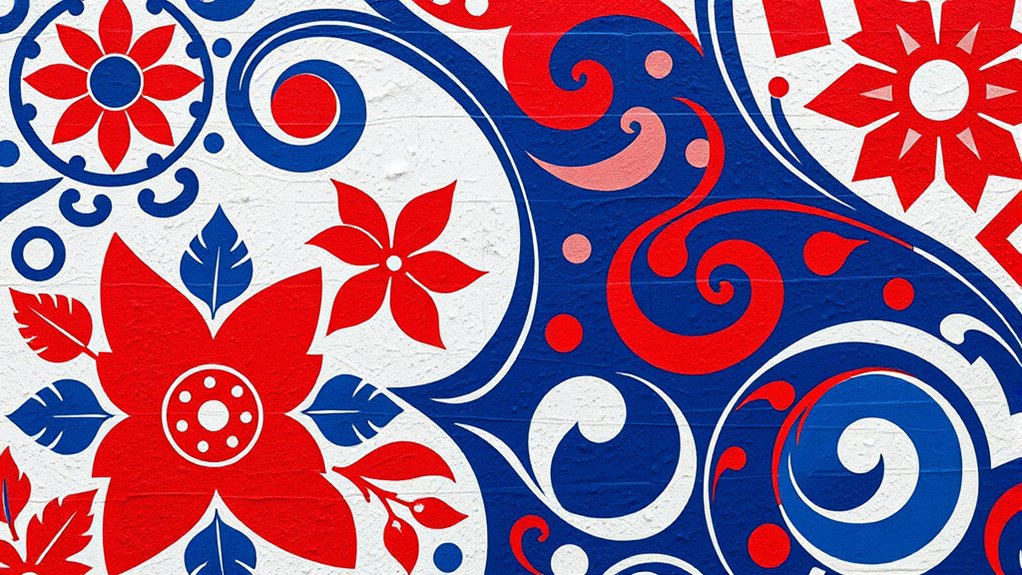
Have contemporary artists found fresh ways to reinterpret Scandinavian folk art? Absolutely. They blend traditional motifs with modern techniques, creating innovative designs. For example, in contemporary textile design, artists incorporate folk patterns into sleek fabrics for clothing and home decor. With digital pattern creation, they experiment with vibrant colors and intricate details that echo historical styles while pushing boundaries. Here are three ways they do this:
Contemporary artists reimagine Scandinavian folk art through modern techniques and vibrant digital designs.
- Merging classic motifs with minimalist aesthetics
- Using digital tools to craft complex, layered patterns
- Reimagining traditional symbols in new, bold color palettes
- Emphasizing cultural heritage preservation to maintain authenticity and relevance
These approaches help preserve the cultural heritage while making it relevant today. By embracing technology and modern sensibilities, contemporary artists keep Scandinavian folk art alive and evolving.
Incorporating Folk Art Into Home Decor and Fashion

Incorporating Scandinavian folk art into home decor and fashion brings a vibrant touch of cultural heritage to everyday life. You can do this by using embroidery techniques to add intricate, colorful patterns to cushions, table linens, or clothing, creating a handcrafted feel. Textile weaving also plays a vital role, allowing you to incorporate traditional motifs into rugs, throws, or scarves that add warmth and authenticity. These techniques give your space and wardrobe a unique, artisanal charm rooted in Scandinavian traditions. Whether you choose bold geometric designs or delicate floral accents, embracing folk art styles helps you celebrate Scandinavian craftsmanship while making your decor and fashion truly distinctive. It’s a beautiful way to keep cultural heritage alive in modern, everyday settings. Additionally, understanding regional resources can inspire you to incorporate authentic motifs and styles that reflect the diverse traditions across Scandinavia.
Preserving and Celebrating Scandinavian Artistic Heritage
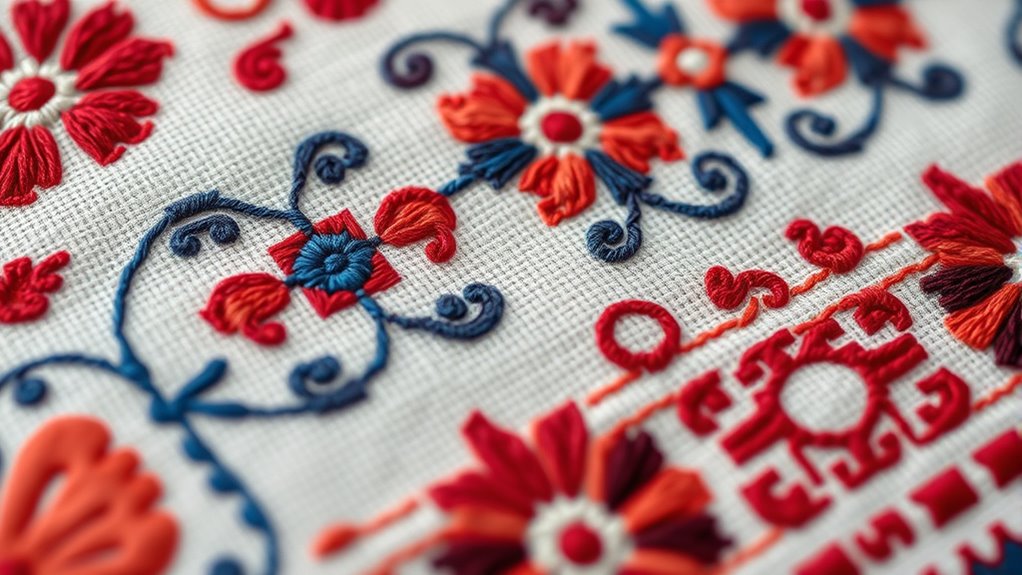
Celebrating Scandinavian artistic heritage guarantees that traditional crafts and motifs continue to thrive in modern times. You can do this by:
Honoring Scandinavian art ensures enduring traditions and vibrant cultural expression today.
- Supporting artisans who preserve textile weaving techniques featuring mythical symbols, ensuring these patterns stay alive.
- Promoting cultural festivals that showcase folk art, including displays of folk costumes with intricate embroidery.
- Educating others about the significance of motifs and symbols, helping to pass down stories embedded in Scandinavian crafts.
- Preserving color accuracy in traditional artworks, which helps maintain the authenticity and vibrancy of Scandinavian folk art colors.
Frequently Asked Questions
How Have Scandinavian Folk Art Patterns Influenced Modern Design Trends?
You see Scandinavian folk art patterns influencing modern design trends through pattern integration and vibrant color palettes. These patterns inspire contemporary textiles, home decor, and fashion, adding a touch of traditional charm. You’ll notice clean lines, geometric shapes, and bold colors echoing Scandinavian aesthetics, creating a sense of warmth and simplicity. This blend of old and new shapes your creative choices, making your designs stand out with timeless appeal.
What Materials Are Traditionally Used in Creating Scandinavian Folk Art?
You’ll find that traditional Scandinavian folk art uses natural materials like wood and fabric. Artists often apply traditional dyes made from plants, roots, and berries to create vibrant colors. Wooden utensils are common, often decorated with painted patterns or carvings. These materials reflect a deep connection to nature and craftsmanship, maintaining a timeless appeal. Embracing these elements helps preserve the authentic look and feel of Scandinavian folk art.
Are There Specific Regions Known for Unique Folk Art Styles?
You’ll find that different regions in Scandinavia have distinct folk art styles, highlighting unique craft traditions and regional distinctions. For example, Sweden’s Dalarna region is famous for its vibrant painted wooden horse, while Norway’s Gudbrandsdal area features intricate rosemaling patterns. These regional variations reflect local history, materials, and cultural influences, giving each area’s folk art its own character and charm that you can easily recognize and appreciate.
How Can Beginners Start Learning Scandinavian Folk Art Techniques?
You can start learning Scandinavian folk art techniques by practicing beginner embroidery and exploring basic color mixing. Begin with simple patterns to build your skills and understand traditional motifs. Use online tutorials or local workshops to guide you through embroidery stitches, and experiment with mixing primary colors to achieve authentic Scandinavian hues. Consistent practice and patience will help you master these techniques and create beautiful folk art pieces.
What Are the Conservation Challenges Facing Scandinavian Folk Art Today?
You face conservation challenges like deterioration from environmental impacts such as humidity, light, and temperature fluctuations. To protect Scandinavian folk art, you should apply preservation techniques like controlled climate conditions, proper storage, and gentle cleaning. Regularly monitor the environment to prevent damage, and consult experts for restoration advice. By actively managing these factors, you help preserve the intricate patterns and vibrant colors for future generations to enjoy.
Conclusion
Exploring Scandinavian folk art is like uncovering a hidden treasure chest of vibrant patterns and rich traditions. By understanding its motifs, colors, and techniques, you can truly appreciate its cultural depth. Whether you’re inspired to incorporate these designs into your home or celebrate the heritage through your style, remember that each piece tells a story—like a timeless melody that continues to resonate. Embrace this art to bring warmth and history into your everyday life.




